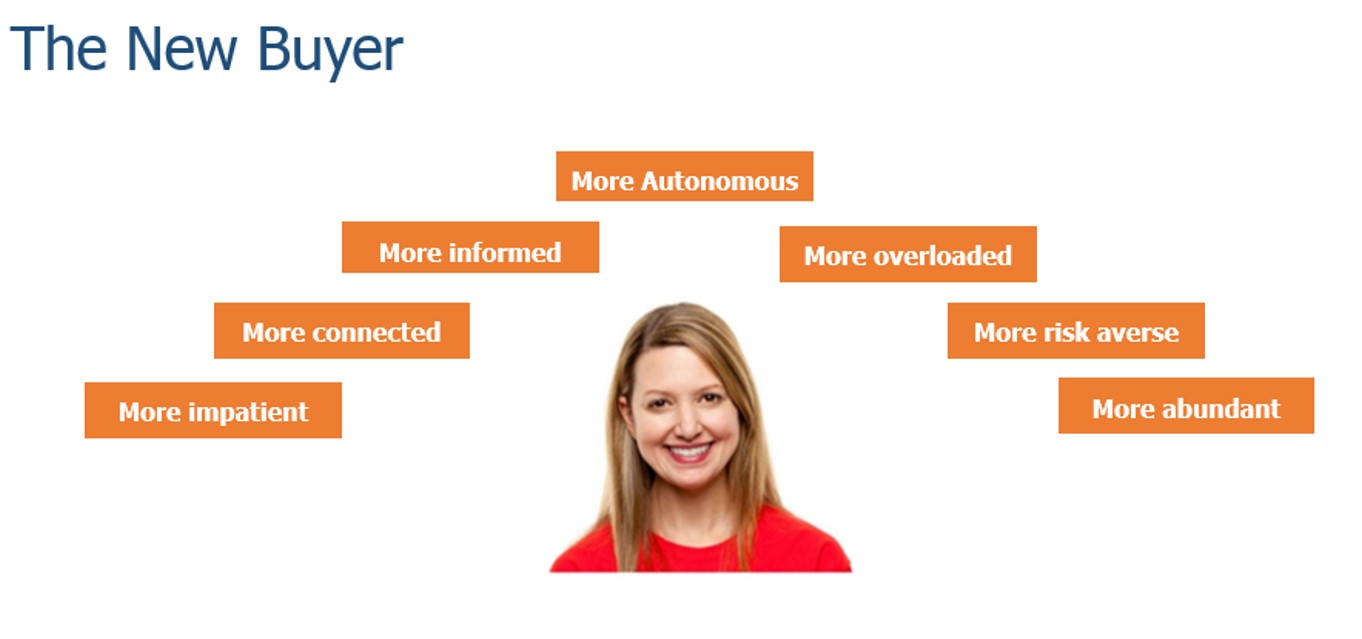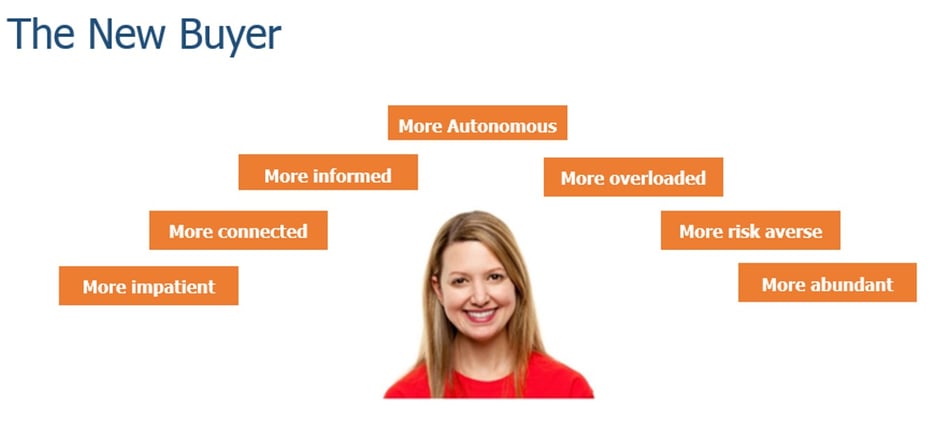The B2B buyer of today is different from the buyer of ten years ago. We’re in the midst of a radical shift towards a new way of buying, which means B2B companies are retooling their marketing and sales strategies.
How is the buyer today different?
The buyer today is different in seven ways from the buyer of the past. Here are the differences and what it means for how companies find and attract new clients.

1. More Informed
Today’s buyer has more information available than ever before, and the amount increases every day.
For just about every business problem, no matter how niche or specific, there are dozens of blogs, articles, and other sources of information. Most business searches yield thousands, if not millions, of results that can range from company websites to aficionado blogs. No matter what the question, buyers can find as much information as they want.
In many cases, the B2B buyer today knows more about how a company’s offerings stack up against competitors’ products than the company’s own sales people.
Savvy B2B buyers find products and services, learn about them online, compare them with competitors, seek out references from others who’ve worked with each company, and read online reviews – all before they ever engage with a salesperson. And when buyers do connect with vendors, they’re better prepared. They’re often ready to jump straight to a quote or pricing – or at least, they think they are.
2. More Connected
Thanks to technology, the New Buyer is more connected than ever before. She no longer relies on cable to connect to the Internet – she has wifi and her mobile network. She’s often on the go, which means she accesses information through a tablet or smart phone. So companies need fast websites that are easy to access from mobile devices.
The New Buyer is also connected to a myriad of information sources. She’s good at finding information online, which means she’ll look at everything: the LinkedIn profiles and group comments of vendors’ teams, the industry associations they belong to, their job postings, user reviews, social media presences, and websites.
Companies tend to think their websites are the only places buyers search – but with the New Buyer, that’s rarely the case. And for companies that haven’t focused on search engine optimization, it’s quite likely third-party sites will rank higher than the company’s own website – making this external information the prospect’s first impression of the company.
3. More Impatient
B2B buyers have become more impatient. They’ve grown used to instant gratification. The New Buyer wants information quickly – immediately in most cases. If a company’s website is slow, the buyer will leave in favor of a faster moving site - after all, she has dozens to choose from. Equally, if she can’t find the information she’s looking for quickly and easily, she’ll move on.
This means that companies need to reply to customer inquiries and provide quotes and proposals faster than they did even three years ago. Firms that try to contact potential customers within one hour of receiving an online query are over six times more likely to have a meaningful conversation with a key decision maker than those who wait two hours – and more than sixty times as likely as companies that wait twenty-four hours or more.
Once the buyer has determined that she’s found the right service or product, she wants to move on to the next step immediately. Empowered buyers want what they want, when and how they want it. Companies need to provide a purchase process that facilitates a customer's desire to buy, not impedes it.
4. More Overloaded
During the 2008/2009 recession, many companies cut staff dramatically. As a result, the remaining staff took on new responsibilities, often in areas where they had less experience. They acquired greater workloads, spanning wider portfolios.
That situation has not really changed – business people have continued to have a greater breadth of responsibility. As buyers, this means they need to undertake more research to have the ability to make informed buying decisions. And for sellers, it means buyers are more difficult to reach because they are strapped for time and often aren’t an apparent buyer based on their title.
5. More Risk Averse
Due in part to the overload and the general increase in pressure within businesses, the B2B buyer today is more at risk than she used to be. It’s easy for sellers to forget that a bad buying decision has a far greater impact on the buyer than on the seller. It could cost her job if things don’t go well. Buyers are understandably risk averse.
6. More Abundant
The new B2B buying process doesn’t involve a buyer – it involves many buyers. Because of the risks involved in B2B purchases, buyers engage more of their col- leagues in the decision in order to avoid a mistake – or at least the perception of a mistake – and to spread the risk.
According to a 2013 study by CSO Insight, over 46% of B2B purchases involve more than four individuals in the final decision. More stakeholders means more buying complexity. Sellers have to not only identify each stakeholder, they also need to address each party’s needs, priorities, and concerns, and find a selling approach that’s reasonable with each. This requires more skill and more resources.
7. More autonomous
Buyers today delay speaking with sales representatives until late in the purchasing process. They want to do their own research, make their own evaluations, and work on their own schedules. Increasingly, this means working outside regular business hours, like during evenings and weekends. The New Buyer wants to be as self-sufficient and independent as possible.
The Seven Differences
These differences are causing a radical shift in the buying process. And when the buying process is radically different, selling needs to be radically different too.
Find us on social:


.png?width=2361&height=488&name=Mezzanine%20Logo_Horiz_RGB_on%20blue%20(1).png)





